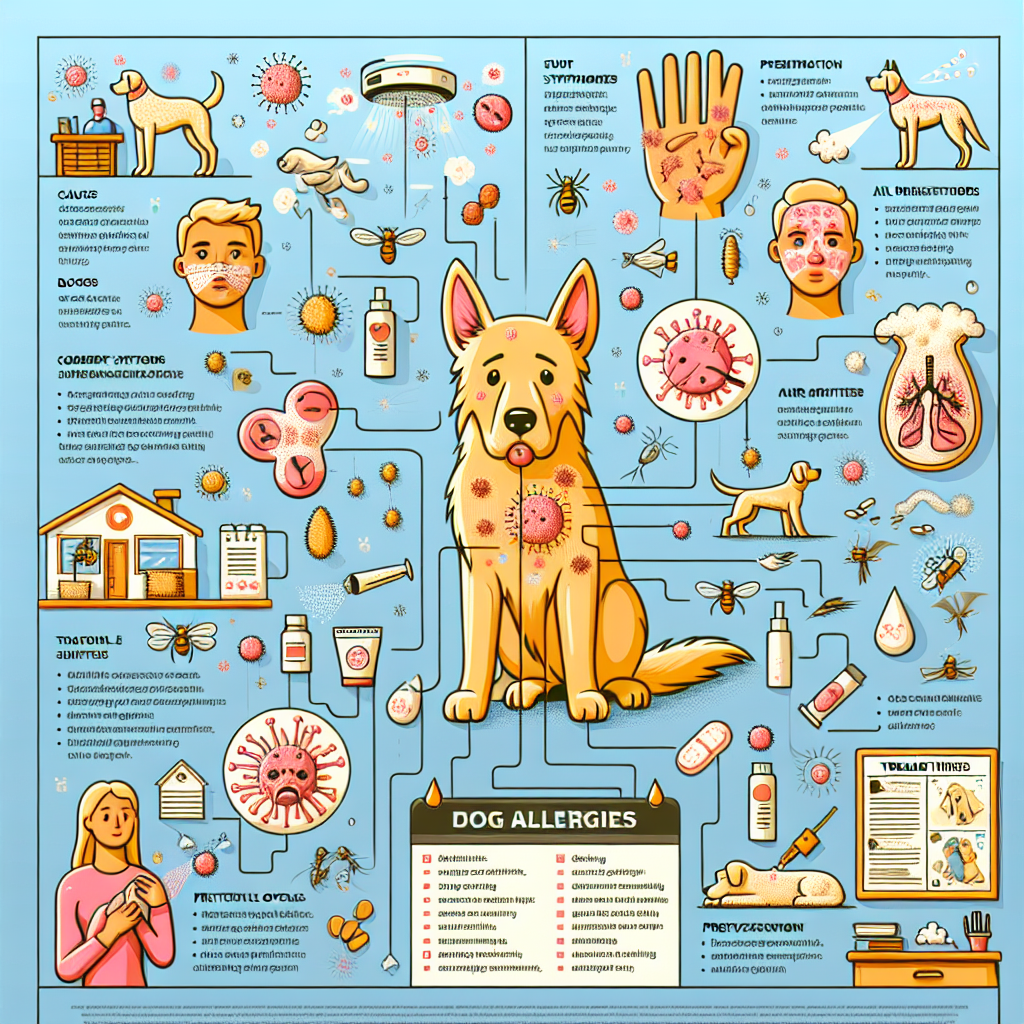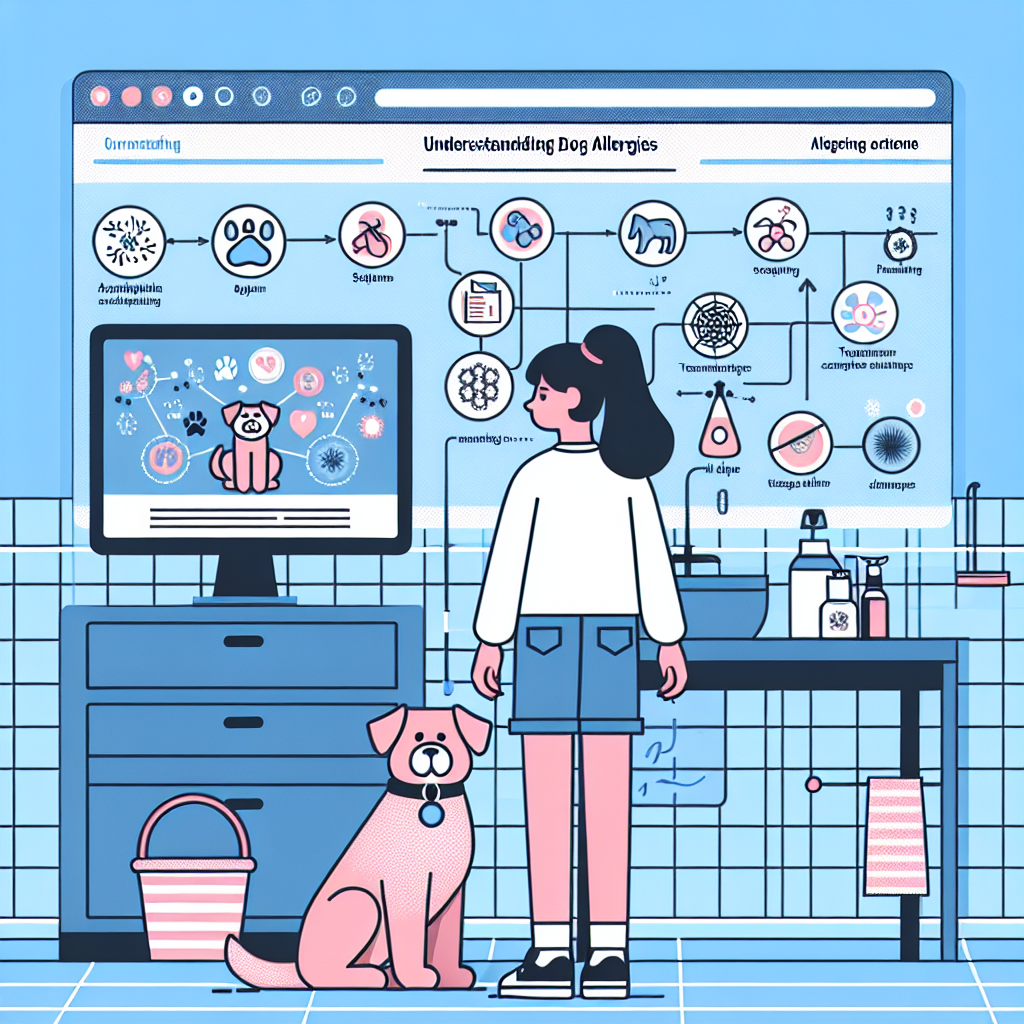If you’re a dog lover who suffers from allergies, you’re not alone. Dog allergies can cause a range of symptoms, from sneezing and itching to more severe reactions. In this article, we will explore the causes of dog allergies and provide practical tips on how to manage them. Whether you’re a current dog owner or considering adding a furry friend to your family, understanding and managing dog allergies is essential for a happy and healthy life together. So, let’s dive into the world of dog allergies and discover how to keep your allergies in check while still enjoying the companionship of your four-legged friend.
What Are Dog Allergies?
Dog allergies occur when the immune system overreacts to certain substances, known as allergens, that are commonly found in dogs. Just like humans, dogs can develop allergies to a variety of environmental and food allergens. These allergies can cause a range of symptoms and can significantly impact a dog’s quality of life.
Types of Dog Allergies
There are three main types of dog allergies: skin allergies, respiratory allergies, and gastrointestinal allergies. Skin allergies, also known as atopic dermatitis, are the most common type and can manifest as itching, redness, and skin inflammation. Respiratory allergies can cause symptoms such as sneezing, coughing, and wheezing. Gastrointestinal allergies can result in vomiting, diarrhea, and gastrointestinal discomfort.
Common Allergens for Dogs
Some of the most common allergens that dogs can be allergic to include pollen, dust mites, mold spores, certain foods such as beef, chicken, and dairy products, and certain types of grooming products like shampoos and conditioners. It’s important to identify the specific allergens that trigger your dog’s allergies in order to effectively manage and treat the condition.
Symptoms of Dog Allergies
Recognizing the symptoms of dog allergies is crucial in determining whether your furry friend is suffering from an allergic reaction. Understanding the different types of symptoms can help you identify the issue and seek appropriate treatment for your pet.
Skin-Related Symptoms
Skin-related symptoms are often the most noticeable signs of dog allergies. These can include excessive itching, redness, rashes, hives, hot spots, and hair loss. Some dogs may also develop skin infections as a result of constant scratching and irritation.
Respiratory Symptoms
Respiratory symptoms in dogs with allergies commonly include sneezing, coughing, wheezing, and difficulty breathing. These symptoms are similar to the ones experienced by humans with respiratory allergies and can be triggered by environmental allergens such as dust mites, mold, or pollen.
Gastrointestinal Symptoms
Dogs with gastrointestinal allergies may experience symptoms such as vomiting, diarrhea, bloating, gas, and general discomfort in the digestive system. These symptoms can be caused by food allergies or sensitivities to certain ingredients in their diet.

Getting a Proper Diagnosis
If you suspect that your dog has allergies, it is important to seek a proper diagnosis from a veterinarian. A veterinarian will be able to evaluate your dog’s symptoms, conduct necessary tests, and provide an accurate diagnosis in order to develop an appropriate treatment plan.
Visiting a Veterinarian
Scheduling a visit with a reputable veterinarian is the first step towards getting a proper diagnosis for your dog’s allergies. During the appointment, your vet will perform a thorough examination and ask questions about your dog’s medical history and symptoms. This information will help them determine the most likely causes of your dog’s allergies and guide the diagnostic process.
Diagnostic Tests for Dog Allergies
There are various diagnostic tests that veterinarians can use to identify the specific allergens causing your dog’s allergies. These tests may include blood tests, skin tests, and food trials. Blood tests can measure the levels of allergen-specific antibodies in your dog’s blood, while skin tests involve introducing small amounts of potential allergens into the skin to observe any allergic reactions. Food trials involve systematically eliminating certain ingredients from your dog’s diet to identify food allergies.
Common Treatments for Dog Allergies
Once your dog has been diagnosed with allergies, your veterinarian will work with you to develop a treatment plan tailored to your pet’s specific needs. Treatment options may vary depending on the severity and type of allergies your dog has.
Medications for Dog Allergies
Medications are commonly prescribed to manage the symptoms associated with dog allergies. These may include antihistamines to reduce itching and inflammation, corticosteroids to control allergic reactions, and immune-modulating drugs to help regulate your dog’s immune response.
Allergy Shots
Allergy shots, also known as immunotherapy, involve administering small amounts of allergens to your dog over time in order to desensitize their immune system. This can help reduce the severity of future allergic reactions and provide long-term relief.
Topical Treatments
Topical treatments such as medicated shampoos, sprays, and creams can provide relief for dogs with skin allergies. These can help alleviate itching, soothe irritated skin, and prevent secondary infections. It is important to choose products that are specifically formulated for dogs and approved by your veterinarian.

Allergy-Friendly Dog Breeds
If you or a family member suffer from dog allergies but still want to share your life with a canine companion, there are certain dog breeds that are considered more allergy-friendly. While no dog breed is completely hypoallergenic, these breeds are known to produce fewer allergens or shed less, making them more suitable for people with allergies.
Hypoallergenic Dog Breeds
Hypoallergenic dog breeds are often recommended for individuals with allergies. These breeds have hair instead of fur, which reduces the shedding of dander and allergens. Some popular hypoallergenic breeds include Bichon Frise, Poodle, Maltese, and Yorkshire Terrier.
Non-Shedding Dog Breeds
Non-shedding dog breeds, such as the Portuguese Water Dog and Afghan Hound, shed very little to no hair, which can help minimize the amount of allergens present in the environment. These breeds are often preferred by individuals with allergies who might be sensitive to dog hair or dander.
Managing Dog Allergies at Home
Managing dog allergies involves creating an allergen-free environment and implementing certain practices to reduce your dog’s exposure to allergens. These measures can help alleviate your dog’s symptoms and improve their overall well-being.
Reducing Allergens in the Environment
Regular cleaning and vacuuming can help reduce the presence of allergens in your home. Use a high-efficiency particulate air (HEPA) filter in your vacuum to trap allergens and consider investing in an air purifier to help clean the air. Additionally, wash your dog’s bedding regularly and keep their living area clean and dust-free.
Regular Bathing and Grooming
Frequent bathing and grooming can help remove allergens from your dog’s coat and skin. Use a hypoallergenic shampoo and conditioner recommended by your veterinarian and make sure to thoroughly rinse your dog to remove any residue. Regular brushing can also help remove loose hair and reduce allergens.
Cleaning Pet Bedding and Furniture
Washing your dog’s bedding and cleaning any furniture or surfaces they frequently come into contact with can help reduce allergens in your home. Use a pet-safe detergent and wash bedding on a regular basis. Vacuum upholstered furniture regularly to remove hair and dander, and consider using washable covers to minimize allergen build-up.
Dietary Considerations for Dogs with Allergies
In some cases, dogs may develop allergies to certain ingredients in their diet, leading to gastrointestinal or skin-related symptoms. Identifying and eliminating these allergens from your dog’s diet can help manage their allergies and improve their overall health.
Common Food Allergens for Dogs
Common food allergens for dogs include beef, chicken, dairy products, wheat, soy, and corn. It is important to read food labels carefully and avoid ingredients that your dog may be allergic to. Your veterinarian may recommend a hypoallergenic or limited ingredient diet to help identify and eliminate potential allergens.
Elimination Diet for Identifying Food Allergies
An elimination diet involves removing all potential allergens from your dog’s diet and gradually reintroducing them one at a time to identify specific allergens. This can help pinpoint the ingredients that trigger your dog’s allergies and allow you to make necessary dietary changes.
Alternative Diet Options
If your dog has multiple food allergies or sensitivities, your veterinarian may recommend alternative diet options such as a raw or homemade diet. These diets can be tailored to meet your dog’s specific nutritional needs while avoiding potential allergens.
Preventing Dog Allergies in Humans
In addition to managing your dog’s allergies, it is important to take steps to prevent dog allergies in humans, especially if you or a family member suffer from allergies.
Limiting Exposure to Allergens
Avoiding direct contact with dogs, especially those known to trigger allergies, can help prevent allergic reactions in humans. If you do come into contact with dogs, wash your hands thoroughly afterwards to remove any allergens that may have been transferred.
Proper Hygiene Practices
Regular bathing, grooming, and brushing for dogs can help reduce the amount of allergens present in their coat and skin. This can minimize the spread of allergens in the home and reduce the risk of allergic reactions in humans.
Reducing Allergens in the Home
Keeping a clean and well-ventilated home can help reduce the presence of allergens that may cause allergic reactions in humans. Regular cleaning, vacuuming, and dusting can help remove allergens from surfaces, while using air purifiers and HEPA filters can help improve indoor air quality.
When to Seek Veterinary Assistance
While mild cases of dog allergies can often be managed at home, there are situations where veterinary assistance should be sought to ensure your dog’s health and well-being.
Recognizing Severe Allergic Reactions
If your dog experiences severe allergic reactions such as difficulty breathing, facial swelling, or collapse, it is important to seek immediate veterinary assistance. These reactions can be life-threatening and require prompt medical treatment.
Managing Chronic Allergies
If your dog’s allergies persist or worsen despite your best efforts, consult with your veterinarian to explore additional treatment options. Chronic allergies can have a significant impact on your dog’s quality of life and may require a more comprehensive management plan.
Consulting a Veterinary Dermatologist
In some cases, a referral to a veterinary dermatologist may be necessary. Veterinary dermatologists specialize in diagnosing and treating skin-related conditions, including allergies. They have advanced training and access to specialized diagnostic tests and treatment options that can help manage your dog’s allergies more effectively.
Living with a Dog Allergy
If you or a family member suffer from dog allergies but still wish to have a furry friend in your life, there are steps you can take to make living with a dog allergy more manageable.
Tips for Dog Allergy Sufferers
For dog allergy sufferers, some helpful tips include keeping your living space clean and allergy-free, washing your hands after interacting with dogs, and avoiding direct contact with allergenic areas such as the dog’s bed or toys.
Creating Allergy-Free Zones
Designating specific areas in your home as allergy-free zones can help minimize exposure to allergens. This can involve keeping dogs out of certain rooms or using air purifiers and HEPA filters in designated areas to reduce the spread of allergens.
Considering Alternative Pets
If dog allergies prove to be too challenging to manage, consider alternative pets that are known to be less allergenic, such as fish, reptiles, or certain breeds of cats. However, it is crucial to thoroughly research and consider the needs of any new pet before making a decision.
By understanding and managing dog allergies, you can provide your furry companion with a healthier and happier life. Whether it’s through proper diagnosis, effective treatment, or making lifestyle adjustments, you can ensure that both you and your dog can coexist in harmony while keeping allergies at bay. Remember, with the guidance of a veterinarian, patience, and a little extra care, you can effectively manage your dog’s allergies and continue to enjoy the amazing bond between humans and dogs.

